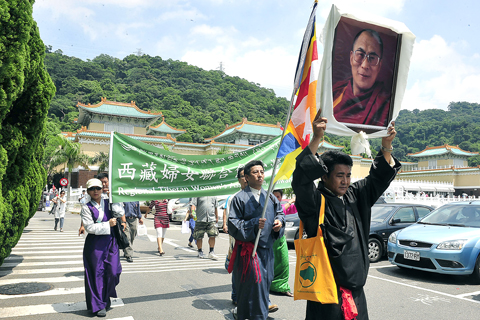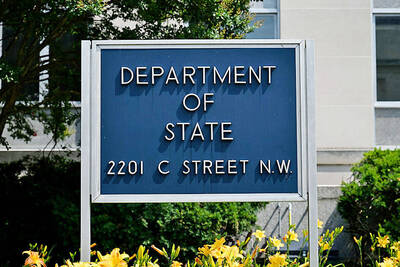Shouting matches and minor clashes erupted at the National Palace Museum yesterday after officials turned down a request by Tibetans and activists to present a photo of the Dalai Lama to “fill the missing part” of an exhibition on Tibetan Buddhist art.
“The Dalai Lama is the highest spiritual leader in Tibetan Buddhism. How could a portrait of the Dalai Lama be missing at an exhibition about Tibetan Buddhism?” asked Regional Tibetan Youth Congress-Taiwan (RTYC-Taiwan) chairman Tashi Tsering, wearing a traditional Tibetan outfit and holding up a large portrait of the Dalai Lama.
Several police officers stood in front of Tashi and other activists, blocking their attempt to enter the exhibition with the picture, asking them to leave immediately.

PHOTO: CHEN YI-CHUAN, TAIPEI TIMES
“If you accept the portrait, we will leave right away,” Tashi said.
Police refused the request, with one officer saying they would not allow anyone to take “that thing” — referring to the Dalai Lama’s portrait — into the venue.
The remarks were not well received by the Tibetans.
“It’s not ‘a thing,’ it’s a portrait of the Dalai Lama, the highest figure in our religion,” they said.
The standoff lasted about 20 minutes.
Police said the activists were in violation of the Assembly and Parade Act (集會遊行法) because they had not applied to hold a political rally. The Tibetans countered that their action was religious as they were there to defend their religion, adding that by law, an assembly and parade permit is not required for religious activities.
“We’re all about religion, it’s the Chinese government that’s trying to politicize everything,” RTYC-Taiwan vice-chairman Tenzin Chunpel said. “They are trying to reinforce the impression that Tibet has always been part of China through this exhibition, that’s why they’re purposely avoiding talking about the Dalai Lama in the exhibition.”
“If we have to apply to deliver a portrait of the Dalai Lama, who applied to the Tibetans to take these pieces of art — which belong to all Tibetans — to an exhibition outside of Tibet?” Chunpel said.
Students for a Free Tibet-Taiwan spokeswoman Jade Kuo (郭聖潔) said items in the exhibition “were stolen by the Chinese government from the Tibetans when they invaded Tibet in the 1950s.”
Although police said the activists should have applied for a permit before the demonstration, an officer told the Taipei Times it would not have been approved even if they had applied.
“We could not possibly have approved the application because it involved politics,” the officer said.
The officer could not explain why, if the application for the rally had been political in nature, it would have been turned down.
“You ask me based on which law?” he said. “Well, maybe I should not answer this question.”
Museum Southern Branch deputy director Lin Chen-feng (林振豐), who is in charge of the exhibition venue, said the museum would only deal with purely cultural and artistic issues.
“[The activists’] demands are political. That’s not something I can respond to,” he said.
Asked why a portrait of the Dalai Lama could not be considered a piece of art, Lin said he did not consider a person’s portrait art.
Failing to receive a positive response from the museum, the Tibetans and their supporters sat down to recite Buddhist chants and sing the Tibetan national anthem before leaving.

A car bomb killed a senior Russian general in southern Moscow yesterday morning, the latest high-profile army figure to be blown up in a blast that came just hours after Russian and Ukrainian delegates held separate talks in Miami on a plan to end the war. Kyiv has not commented on the incident, but Russian investigators said they were probing whether the blast was “linked” to “Ukrainian special forces.” The attack was similar to other assassinations of generals and pro-war figures that have either been claimed, or are widely believed to have been orchestrated, by Ukraine. Russian Lieutenant General Fanil Sarvarov, 56, head

SAFETY FIRST: Double the number of police were deployed at the Taipei Marathon, while other cities released plans to bolster public event safety Authorities across Taiwan have stepped up security measures ahead of Christmas and New Year events, following a knife and smoke bomb attack in Taipei on Friday that left four people dead and 11 injured. In a bid to prevent potential copycat incidents, police deployments have been expanded for large gatherings, transport hubs, and other crowded public spaces, according to official statements from police and city authorities. Taipei Mayor Chiang Wan-an (蔣萬安) said the city has “comprehensively raised security readiness” in crowded areas, increased police deployments with armed officers, and intensified patrols during weekends and nighttime hours. For large-scale events, security checkpoints and explosives

PUBLIC SAFETY: The premier said that security would be tightened in transport hubs, while President Lai commended the public for their bravery The government is to deploy more police, including rapid response units, in crowded public areas to ensure a swift response to any threats, President William Lai (賴清德) said yesterday after a knife attack killed three people and injured 11 in Taipei the previous day. Lai made the remarks following a briefing by the National Police Agency on the progress of the investigation, saying that the attack underscored the importance of cooperation in public security between the central and local governments. The attack unfolded in the early evening on Friday around Taipei Main Station’s M7 exit and later near the Taipei MRT’s Zhongshan

REBUFFED: In response to Chinese criticism over recent arms sales, Washington urged Beijing to engage in meaningful dialogue instead of threats and intimidation Washington’s long-term commitment to Taiwan would not change, the US Department of State said yesterday, urging Beijing to stop pressuring Taiwan and engage in meaningful bilateral dialogues. The remarks came in response to a backlash from Beijing about Washington’s latest approval of arms sales to Taiwan. The US Defense Security Cooperation Agency said in a statement on Wednesday that the Taipei Economic and Cultural Representative Office in the US has asked to purchase an arms package, including Tactical Mission Network Software; AH-1W helicopter spare and repair parts; M109A7 self-propelled howitzers; HIMARS long range precision strike systems; tube-launched, optically tracked, wire-guided missiles; Javelin